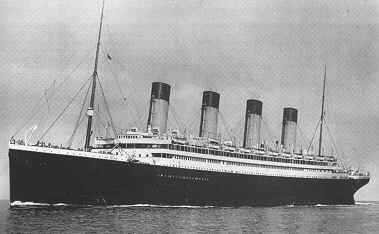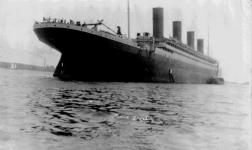
Olympic - "The Old Reliable"

The Olympic, the first of three enormous vessels, was first launched on October 20th, 1910. After final construction, she began her maiden voyage in June, 1911. Before the completion of the Titanic, she was the largest ship in the world and, later, regained that title until the construction of the German ship Imperator.
Although not as lavish as the Titanic, the Olympic was a model of craftmanship and luxury. Although very closely matching, there were differences between the Olympic and Titanic. The promenade deck on the Olympic, for example, was fully open while the Titanic was fitted with windowed covers over 1/3 of the length of the promenade deck. The Titanic also had some extra luxurious suites on the B deck that the Olympic lacked.
 An incident between the Olympic and a small 7,350 ton British cruiser
named Hawke occured while she was under the direction of Captain E.J. Smith on the 20th of
September, 1911. She was coming around a bank (Bramble Bank) at a speed of around 19 knots
when she encountered the Hawke. According to sources at the time, the two ships were aobut
100 - 300 feet apart when the Hawke was suddenly pulled towards the Olympic. Unable to
avoid a collision, the Hawke speared itself into the starboard side of the Olympic and
caused serious damage. The bow of the Hawke was smashed and two gashes were left in the
Olympic - one below the water line and one above. Fortunately, no one was killed and the
two ships were able to make it back to port under their own power. What caused this
incident? It is most likely that the suction created by the larger ship Olympic actually
pulled the hapless Hawke into her side.
An incident between the Olympic and a small 7,350 ton British cruiser
named Hawke occured while she was under the direction of Captain E.J. Smith on the 20th of
September, 1911. She was coming around a bank (Bramble Bank) at a speed of around 19 knots
when she encountered the Hawke. According to sources at the time, the two ships were aobut
100 - 300 feet apart when the Hawke was suddenly pulled towards the Olympic. Unable to
avoid a collision, the Hawke speared itself into the starboard side of the Olympic and
caused serious damage. The bow of the Hawke was smashed and two gashes were left in the
Olympic - one below the water line and one above. Fortunately, no one was killed and the
two ships were able to make it back to port under their own power. What caused this
incident? It is most likely that the suction created by the larger ship Olympic actually
pulled the hapless Hawke into her side.
After the Titanic disaster, the Olympic was put back in dry dock at Harland & Wolff where she was refitted in order to make her safer. Extra life boats were added and her double bottom was extended giving her a 2 layered skin. This increased her tonnage from 40,000 to around 46,000 tonnes. In the spring of 1913 her refitting was finished and she was put back into service on the North Atlantic seaway.
The Olympic
had an impressive history of service. Just after the start of World War I, she rescued the
crew of a British battleship called Audacious which had struck a mine near the coast of
Ireland. Shortly after this, in  1915, she was commisioned as a naval transport. Painted in dazzling colours
with geometric shapes on a yellow background (which was supposed to confuse u-boat
captains but the actual effectiveness of this technique has never been verified) she
carried troops to the war front. During this service, which lasted for the entire war, she
was attacked by u-boats four times but managed to survive. An interesting event occured in
May of 1918 when, during the Olympic's 22nd troop carrying voyage, she was attacked by a
U-103 German u-boat. She narrowly avoided being torpedoed by quick evasive action and,
amazingly, turned on the submarine and rammed it! Although only a glancing blow, the
u-boat quickly sank but some of her crew managed to escape. They were later picked up by
an American destroyer that happened to be passing by.
1915, she was commisioned as a naval transport. Painted in dazzling colours
with geometric shapes on a yellow background (which was supposed to confuse u-boat
captains but the actual effectiveness of this technique has never been verified) she
carried troops to the war front. During this service, which lasted for the entire war, she
was attacked by u-boats four times but managed to survive. An interesting event occured in
May of 1918 when, during the Olympic's 22nd troop carrying voyage, she was attacked by a
U-103 German u-boat. She narrowly avoided being torpedoed by quick evasive action and,
amazingly, turned on the submarine and rammed it! Although only a glancing blow, the
u-boat quickly sank but some of her crew managed to escape. They were later picked up by
an American destroyer that happened to be passing by.
Even after the war the Olympic continued her reliable record of service. During her lifetime she had transported 66,000 troops, 41,000 civilian passengers, and 12,000 members of a Chinese labor battalion, burning a total of 347,000 tonnes of coal and travelling 184,000 miles! She was given the nickname "Old Reliable", a name which she certainly lived up to.
In March of 1935, due to loss of business to newer vessels, she was sold, stripped and eventually scrapped. Paintings and interiors (such as panels) from the Olympic were sold to various English pubs and estates where they can still be seen to this day.